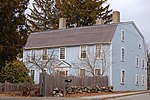North Shore Community College
1965 establishments in MassachusettsAviation schools in the United StatesCommunity colleges in MassachusettsMassachusetts school stubsNortheastern United States university stubs ... and 3 more
Two-year colleges in the United StatesUniversities and colleges established in 1965Universities and colleges in Essex County, Massachusetts
North Shore Community College is a public community college in Massachusetts with campuses in Danvers, and Lynn. The college offers over 80 associate degree and certificate programs to approximately 10,000 students a year from the 26 cities and towns along the coastal region from north metropolitan Boston to Cape Ann. North Shore Community College is accredited by the New England Commission of Higher Education.
Excerpt from the Wikipedia article North Shore Community College (License: CC BY-SA 3.0, Authors).North Shore Community College
Village Road, Danvers
Geographical coordinates (GPS) Address Nearby Places Show on map
Geographical coordinates (GPS)
| Latitude | Longitude |
|---|---|
| N 42.590138888889 ° | E -70.968194444444 ° |
Address
North Shore Community College
Village Road
01937 Danvers
Massachusetts, United States
Open on Google Maps








